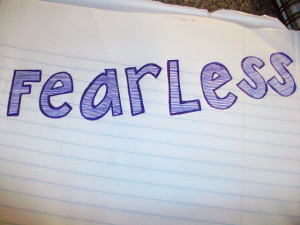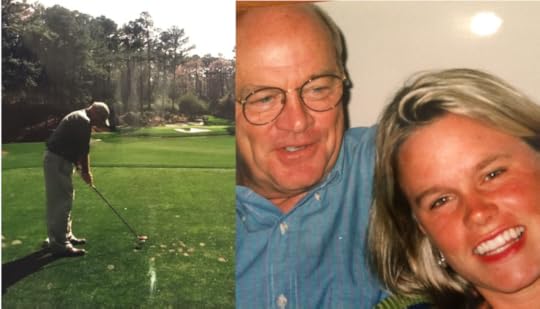Molly Fletcher's Blog, page 22
July 20, 2015
5 Leadership Books To Inspire Your Team
Great leaders are always learning, and one of my favorite questions to ask them is, “What are you reading?” Their answers almost always inspire me, and that helps me inspire others.
and one of my favorite questions to ask them is, “What are you reading?” Their answers almost always inspire me, and that helps me inspire others.
This summer, check out these five titles that are guaranteed to sharpen your leadership.
Dare to Serve: How to Drive Superior Results by Serving Others , by Cheryl Bachelder, the CEO of Popeye’s Louisiana Kitchen. This restaurant chain achieved a remarkable turnaround, guided by her emphasis on courage and humility. We met recently at the Judson Women’s Leadership Conference, and Cheryl’s attitude of confident service is even more impressive in person. If you’re leading a struggling team, study her bold servant leadership.
Do the KIND Thing: Think Boundlessly, Live Purposefully, Live Passionately , by Daniel Lubetzky. Not many leaders or companies do more than one thing well. Daniel Lubetzky and the KIND snack company has published a recipe of sorts for blending a successful business with a higher cause—for him, that means making the world a more compassionate place. I love the legacy of resiliency in Daniel’s story, that his father survived the Holocaust only through the goodwill of others. If your team needs inspiration, read Daniel.
Rising Strong: The Reckoning. The Rumble. The Revolution . I’m counting down till next month’s publication of the latest from one of my very favorite leaders, Brené Brown. Much of her work and speaking is around the concept of “enough,” and this book examines the courage to repeatedly be brave enough often enough. Falling is inevitable, and Brené says “this is a book about what it takes to get back up.” If your team faces a big challenge, read Brené.
Triggers: Creating Behaviors that Last, Becoming the Person You Want to Be , by Marshall Goldsmith, an executive coach. I like how this book dials in on building positive habits. He also challenges readers to leverage regret instead of absorbing its toxicity. If your team is rebounding from adversity, read Marshall.
Work Rules!: Insights from Inside Google That Will Transform How You Live and Lead , by Laszlo Bock, who is in charge of the company’s hiring, human relations and has set the gold standard for companies that everyone wants to work for. The double meaning of this title promises (and delivers) a guide to creating a motivating, humane environment where your people thrive. The key is freedom and data. If your team is establishing a new culture, read Laszlo.
Your Game Changer Takeaway
What are you reading this summer? I’m always looking for great titles to dive into and possibly recommend. If you have a leadership bestseller that more leaders should know about, I want to hear from you. Have a great summer of reading!
Molly Fletcher helps inspire and equip game changers to dream, live and grow fearlessly. A keynote speaker and author , Molly draws on her decades of experiences working with elite athletes and coaches as a sports agent, and applies them to the business world. Sign up here to receive our monthly newsletter.
The post 5 Leadership Books To Inspire Your Team appeared first on Molly Fletcher.
July 14, 2015
4 Tips to Being Relentless from those at the Top
Only a very small percentage of people are considered the best at what they do. And among this group, the outliers aren’t satisfied with being the best. They strive to distance themselves from their competition.
considered the best at what they do. And among this group, the outliers aren’t satisfied with being the best. They strive to distance themselves from their competition.
So what is the secret sauce? Attitude? Talent? Luck? None of those are adequate. In my years of studying athletes, coaches and broadcasters who are not satisfied with being at the top of their fields, there’s one characteristic that sets them apart.
They are relentless.
They own the ability and mindset to never stop trying and pushing toward a goal that only they can see. No one else has ever done it before. They are incredibly inspiring, and for me as a corporate keynote speaker, it’s such an incredible honor to learn from them and share that message with others who can benefit.
Here are four important pointers about being relentless.
The two-minute memory rule: Celebrate your accomplishments for two minutes and reflect on your failures for two minutes, and no more. If you focus too much on your success, you become complacent. If you dwell too much on your failure, you become fearful and lose confidence. This way you stay nimble and dynamic; you’re in the moment. Compartmentalizing is essential for bringing all your attention to the task at hand: moving even further ahead of your nearest competitor. This Foot Locker ad riffs on the theme that “all the greats have short memories.” Funny ad—and true.
Your best measuring stick is invisible: Elite performers recognize that the most meaningful level of competition is personal. It’s inside them; it’s them against themselves. They define the standard of excellence rather than letting the competition set the bar; they rate themselves against their own potential. Their driving question: What have I done today to get better than I was yesterday? Warren Buffett is an example of thinking this way.
Minimize your gaps: NBA superstar Kevin Durant was one of the best players in the world when he hired his own analytics guru. This trainer identified inefficiencies in Durant’s game and tailored workouts to address them. The best get better the same way in business—embrace constructive feedback, identify your biggest gaps, and come up with a game plan to minimize them.
Fearlessly reinvent yourself: Pushing to a new level of achievement creates a new set of challenges, and you have to be ready to constantly reposition yourself. This means suffocating fear and cultivating an insatiable appetite for learning.
Your Game Changer Takeaway
As a corporate keynote speaker, I not only speak about these four aspects of being relentless, but I use them in my work. I want to break new ground in my profession and go beyond best to discover my ultimate potential. To do that, I know I must be relentless. If you strive to be a pioneering achiever in your field, you need to be relentless too. Keep these four points in mind and go for it!
Molly Fletcher helps inspire and equip game changers to dream, live and grow fearlessly. A keynote speaker and author , Molly draws on her decades of experiences working with elite athletes and coaches as a sports agent, and applies them to the business world. Sign up here to receive our monthly newsletter.
The post 4 Tips to Being Relentless from those at the Top appeared first on Molly Fletcher.
June 30, 2015
Find Your Inner Fearlessness
Fearlessness is an engine  that can get us to a goal and overcome the biggest obstacles. So how do we nurture it in our lives to get more of it?
that can get us to a goal and overcome the biggest obstacles. So how do we nurture it in our lives to get more of it?
The fear part of our brain can adapt if we practice new habits—the same way that man’s best friend is trained to be less fearful. Here are five keys to practicing more fearlessness in your life and making it automatic.
Connect with your why. Passion suffocates fear. Remember the “why” behind the action you are taking. That why is your inner motivator that will push you beyond your fear. Reframe fear as the nervous, excited energy that precedes anything worth having!
Put things in perspective. Refusing to acknowledge your fears sometimes can have an unintended consequence—your fears actually loom larger. Perspective reminds us that often what we are afraid of, actually isn’t that big of a deal.
Find your fearless role models. They see the world through the lens of opportunity and curiosity. They are encouragers who know in their bones that anything is possible, that excuses are not an option, and that a way can be found if you just keep trying. On the flip side, minimize your exposure to fearfulness. If you are around naysayers, you’re not feeding your boldness.
Practice bite-size bravery. Fearlessness starts small. Rehearse memories of moments when you demonstrated courage and how empowered you felt, and envision yourself taking on bigger challenges. As Brene Brown points out (from theologian Mary Daly): “You learn courage by couraging.”
Reward yourself for overcoming your fear. We all look forward to new situations with anticipation if there’s a treat. Give yourself something good for developing your new habit of more fearlessness!
Your Game Changer Takeaway
Replace fear with fearlessness through positive feedback. What are your mental treats for feeding more fearlessness in your life? Keep them handy for when the fear arises, and watch your positive energy expand. You’re more fearless than you know.
Molly Fletcher helps inspire and equip game changers to lead well and with purpose. Her book, “ A Winner’s Guide to Negotiating: How Conversation Gets Deals Done ” (McGraw-Hill, 2014), draws on her decades as a sports agent and negotiator on behalf of pro athletes, coaches and broadcasters. Sign up here to receive our monthly newsletter.
The post Find Your Inner Fearlessness appeared first on Molly Fletcher.
June 22, 2015
Three Steps to Hire the (Right) Top Talent
Corporate teams who  are looking for an edge in landing the best talent would do well to borrow from the best pro teams. This week’s NBA Draft highlights three steps that corporate leaders can follow to make sure they hire top talent that’s right for them.
are looking for an edge in landing the best talent would do well to borrow from the best pro teams. This week’s NBA Draft highlights three steps that corporate leaders can follow to make sure they hire top talent that’s right for them.
Look for candidates who are coachable.
You don’t want the Lone Ranger on your basketball team or any other team; you want an expert colleague who embraces feedback and has a growth mindset. This perspective is based in a desire to learn. It embraces challenges, persists despite obstacles, thinks of effort as a means to mastery, and welcomes the chance to learn from constructive criticism. A person with this mindset views others’ success as a window into lessons and inspiration for even greater personal success, fueled by the power of free will (not expectation).
So how do you find out if the candidate has the chops? All pro teams have tryouts, and so do great corporate teams.
At SalesForce, for instance, candidates must jump into a team environment. At recruiting workshops, invited candidates work within teams to propose solutions building an employee mobile app or improving the company’s “order-to-quote” process. These are real challenges, not fiction. SalesForce is looking for traits in action, like leadership, emotional intelligence and self-awareness.
Invite multiple perspectives.
A pro team has a coach and recruiting staff to filter talent and see what fits best. So do the top corporate teams. The more perspectives, the better the fit for the employee and team. Selection shouldn’t be up to one person, but include many viewpoints.
How does Google sift 2 million applications annually (making it 25 times more selective than Harvard, Princeton or Yale)? Not only does it ensure every application is considered, a team reviews rejected applicants to see if a valuable candidate was overlooked.
At Amazon, CEO Jeff Bezos says setting the bar high in hiring is the biggest reason for his company’s success. “Bar raisers” are employees throughout the company who volunteer to be part of interview committees. Each job candidate gets vetted by five or six “bar raisers.”
Consider hiring a two-way street.
Doc Rivers didn’t have to have a coaching job when he returned to the NBA. Our agency represented him at the time, and he went into negotiations interviewing the team as much as the team interviewed him. (The full story is told in my book.) Doc wanted to nail down what the expectations of him would be and how he would relate to his players. He asked questions like: What’s broken with the current team? Who controls draft picks and trades (recruiting and hiring)? What are the ownership’s goals?
This is a great trait in a job candidate. Look for candidates that interview you as much as you interview them. You want to attract candidates who are genuinely curious and engaged in the process. Consider it a good sign if a job candidate asks tough questions about how he or she will be challenged in the role.
Your Game Changer Takeaway
The fast pace and wide reach of talent recruitment means that you need to have a sure way to connect with the right fit for your team. Your next hire will be a better fit by looking for coachable candidates, inviting multiple perspectives and embracing those who interview you (not just vice versa; it’s a two-way street). The most successful pro teams do this, and so can yours.
Molly Fletcher helps inspire and equip game changers to lead well and with purpose. A keynote speaker and author , Molly draws on her decades of experiences working with elite athletes and coaches as a sports agent, and applies them to the business world. Sign up here to receive our monthly newsletter.
The post Three Steps to Hire the (Right) Top Talent appeared first on Molly Fletcher.
June 15, 2015
A Dad’s Best Leadership Advice
Simply put, my dad is a badass. He is 78, plays multiple rounds of golf each day, or gets on his bike and rides 50 miles at a stretch. At his weakest, he suffered a heart attack after playing tennis one day, and I witnessed him pull through the pain and survive triple bypass surgery. As his only daughter, of course I think of him (especially this week leading up to Father’s Day) as bulletproof.
More important than my opinion is the value of his example for leadership—mine and yours. My father is a great role model for showing, not just telling, the best way forward. He is a leader through his actions, and that is the most influential type of leader. Here are his strengths that have meant the most to me.
1. His actions align with his values.
Dad grew up in Detroit, and his dad worked on the line for Chrysler while his mom worked as a nurse. Dad played football at Hillsdale College and then became a pharmaceutical sales rep. He was great at his job, but when promotions came that would have moved us to New Jersey, that was a quick no for him. Uprooting us for money didn’t fit my Dad. His family’s stability and consistent roots were foremost, and he modeled the power of belief for us.
2. He showed up.
He was and is always there for the moments that mattered. For me, it was competitive tennis, and he watched every one of my matches in junior tennis, high school and college.
He shows up for dialogues that matter. He’s a great listener, and doesn’t back down on giving advice when warranted. I learned so much this way. When I would lose a match I thought I should have won, Dad would sit beside me, rub my back and give me just the right amount of love for the situation. If I drowned in the loss too long, he would kick me in the butt and say, “Get over it.” It was more important to him to say and do what was right than to be liked.
3. His actions didn’t follow the crowd.
When I needed a car as a teenager, my parents bought me a big beat-up station wagon. My friends drove better by far. But my dad knew that heavy clunker would keep me safe driving in Michigan’s ice and snow. So what if it didn’t look great? It got the job done.
When cell phones and car antennas became popular, he responded by getting me a $5 plastic phone, and taped an “antenna” near the back window. When I pulled up to a light, next to a cute boy in a car, I picked up the plastic phone to impress him. That was dad’s sense of humor coming through.
4. He aimed for (and found) the sweet spot of interpersonal relationships.
I honestly think of my dad as a perfect dad. He knew just how much to push, how much to love, how much to work, how much to keep me and my twin brothers scared of him, how much to toughen up. He knew when to be soft, and how to find that challenging place between just enough and too much.
My childhood home has two big hills in the front and back yards. I would mow it with a push mower. He would tell me to do just the back yard, but if I got done and felt pretty good, he would tell me I had it in me to keep going.
And I did, and those times taught me the value of persistence and the satisfaction of extra effort in a job well done.
Your Game Changer Takeaway
My dad is a great example of discipline and focus. He likes effort, but I learned early and often that he likes results even more.
Now it’s your turn: What leader has shown you the best way forward through his or her actions? How can you be that kind of leader (or parent) today?
Molly Fletcher helps inspire and equip game changers to lead well and with purpose. A keynote speaker and author , Molly draws on her decades of experiences working with elite athletes and coaches as a sports agent, and applies them to the business world. Sign up here to receive our monthly newsletter.
The post A Dad’s Best Leadership Advice appeared first on Molly Fletcher.
June 9, 2015
Great Leaders Spur Teams to Dream Big with Inspirational Messages Like These
 If you’re a great leader, you probably have a team that dreams big. A team that is inspired. That’s because the messages you’re sending every day in multiple ways fuel the motivation to keep reaching higher and more audaciously.
If you’re a great leader, you probably have a team that dreams big. A team that is inspired. That’s because the messages you’re sending every day in multiple ways fuel the motivation to keep reaching higher and more audaciously.
What makes these leaders so effective? Inspirational messages like these.
1. They answer the question, “Why do we exist?”
John Mackey, the co-founder and CEO of Whole Foods, inspires his staff through a clear purpose: to improve the health and well-being of people and the planet. Notice that it’s not simply selling food. Employees are encouraged to draw upon the values that resonates most with them, and express those values in their work. It’s an inspirational message that works.
Southwest Airlines, led by chairman/CEO Gary Kelly, connects people to what’s important in their lives through friendly, reliable, and low-cost air travel. A trip on Southwest is valued for being the means to an end (your important values), thus linking it to something bigger and more personal than the service it provides.
Make it yours: Can your team answer the question, “Why do we exist?” Is your purpose merely words on a mission statement—or tied into everything you do?
2. They spur innovation by investing in their people
Google founders Sergey Brin and Larry Page established “20% time” to encourage employees to spend a fifth of their time on independent projects. “This empowers them to be more creative and innovative. Many of our significant advances have happened in this manner,” they said in their 2004 IPO letter, mentioning AdSense and Google News. “Most risky projects fizzle, often teaching us something. Others succeed and become attractive businesses.”
One day a week is a lot, and it shows how much Google values the space to tinker and to challenge conventional wisdom, which is the heart of innovation.
Make it yours: A great leader inspires their team to have confidence in themselves. As Brin says, “I would like to see anyone be able to achieve their dreams, and that’s what this organization does.”
3. They create shared history through unique stories.
Nike’s Innovation Kitchen is a 1972 Winnebago that allows team members to go back in time, when cofounder Phil Knight first sold shoes out of the back of an RV. The Nike campus also displays the waffle iron that Knight’s cofounder Bill Bowerman used in the 1970s to make rubber soles.
Telling the story that only you can tell has a wonderful glow and sense of purpose for those who are carrying on the story. Your authentic story makes them feel part of something that is truly special. This is the essence of pride, and it shows at Nike. Retention is so high that unless you have more than 10 years there, you’re considered a rookie.
Make it yours: Does your team know their roots? Your history can be a source of great energy and inspiration. Bowerman said this to his runners and it’s true about your most resonant inspirational message: “Everything you need is already inside.”
Your Game Changer Takeaway
Inspirational messages tap the past to inform the present and create aspirations for the future. A great leader strives to plant and nurture seeds of inspiration in team members, by establishing purpose, investing in them and casting them as characters in an authentic, unique story.
Molly Fletcher helps inspire and equip game changers to lead well and with purpose. A keynote speaker and author , Molly draws on her decades of experiences working with elite athletes and coaches as a sports agent, and applies them to the business world. Sign up here to receive our monthly newsletter.
The post Great Leaders Spur Teams to Dream Big with Inspirational Messages Like These appeared first on Molly Fletcher.
June 4, 2015
When Pressure Gets Big, the Best Performers Think Small
The NBA Finals open this week as one of the great pressure cookers in sports. Over my decades of observing athletes and teams who perform at their peak when the pressure is highest, I’ve seen an important pattern.
They think small.
Thinking small helps them absorb intense scrutiny, relax and make success under pressure almost look easy. By thinking small, they are tricking their perception of the pressure and almost eliminating it. They are masters at psychological preparation, and you can copy their habits to perform at your peak in situations where you experience the greatest pressure.
Three examples of thinking small
* Stick to the game plan: Top performers trust in what got them there in the first place. When the pressure turns up, they know they’ve prepared for the moment. NBA MVP Steph Curry puts it this way: “On the big stage, everything slows down… You know it’s do or die, but you treat it like it’s game 27.” Take a page out of Curry’s book and think small—don’t let the enormity of the moment overwhelm you. Have confidence in what’s gotten you this far and trust that you can make the pivots needed to be successful.
* Quiet the noise: Pressure-filled moments are usually accompanied by distractions and external chatter. The best performers find ways to quiet their minds. That’s why you might see NBA superstar Lebron James reading The Hunger Games in the locker room before a playoff game. He clears his mind of clutter by reading books. Quiet the noise by creating a small ritual. For me, that means a 30-minute workout before I hit the stage for a keynote. What cuts through clutter for you?
* Don’t fuel your fears: What starts as energy often turns to anxiety if we don’t channel our emotions positively. Send yourself the right messages and focus on the optimal outcome. Envision success. For a big league pitcher, it’s sitting down the next batter. For you, it might be walking out of the room with a handshake signifying a deal got done. Amy Cuddy’s TED talk on body language reveals how simple mannerisms can give us greater confidence and focus, especially when we need it most. That’s the essence of thinking small to position yourself (literally) for success.
Your Game Changer Takeaway
When the stakes get high, the top performers use small habits and patterns to shrink the pressure to a manageable level. No matter how much stress is around you, what small distractions might help you relax and do what you do best? Thinking small is a key to big success.
Molly Fletcher helps inspire and equip game changers to lead well and with purpose. A keynote speaker and author , Molly draws on her decades of experiences working with elite athletes and coaches as a sports agent, and applies them to the business world. Sign up here to receive our monthly newsletter.
The post When Pressure Gets Big, the Best Performers Think Small appeared first on Molly Fletcher.
May 26, 2015
The Power of Humility for Millennial Graduates
When you achieve something  big like a college diploma, your ego is bound to be big and happy. For a millennial graduate, you’ve got a paper proving how special you are. No one should knock that.
big like a college diploma, your ego is bound to be big and happy. For a millennial graduate, you’ve got a paper proving how special you are. No one should knock that.
But most achievements set you up for starting over, and this is when you really want to check in with your attitude. It’s a paradox: by embracing humility, you will make yourself stand out.
You’re not the majority.
Your status as a college graduate puts you squarely in the minority. Did you know that almost two-thirds of American adults have no higher education? This means that most people will not share your learning experiences or training. Humility is the understanding that what you have achieved does not make you better; it makes you different.
Leave the screen.
So how do you connect to the people and resources you need for success at the next level? Meredith Vieira gave some practical advice about humility to Boston University graduates this month that’s worth mentioning: “If you want to get your foot in the door, it helps to get your fingers off your smartphones, look people in the eye, engage. You want people to actually like you, not just give you ‘likes.’ Ultimately, your future is in the hands of humans, not electronic devices.”
Be an authentic chameleon.
For greater humility in your interpersonal relationships, strive to be an authentic chameleon. That’s my term for the sweet spot between humility and confidence. It the smart development of your social intelligence. The authentic chameleon knows how to read people and situations for the right level of humility and confidence to create a maximum connection.
One example is Diana Nyad, Her mental toughness and strength got her across the finish line; in humility, she invited others to share the moment of celebration.
Believe and you don’t have to prove.
Humility does not mean humiliation. It is anchored by quiet confidence—the trust in your inner compass—which is common advice from commencement speakers.
“Don’t let the noise of others’ opinions drown out your own inner voice,” Steve Jobs said in his famous address to Stanford graduates. “And most important, have the courage to follow your heart and intuition.”
Your Game Changer Takeaway
People in the C-suite consider a college graduate much like a drafted football or baseball player. The foundation is there, the potential is exciting, the person is prepared and positioned well. But there’s no experience in the pro leagues yet – a perfect time to be an authentic chameleon to bridge the gap.
When you walk off campus with your diploma, determine to be a sponge, be curious, be respectful and grateful. Recognizing that you have a lot to do to be special at the next level will automatically put you ahead of other millennials who lack humility. This is a key to becoming your best self as you seek the purpose and success meant expressly for you.
Molly Fletcher helps inspire and equip game changers to lead well and with purpose. Her book, “
A Winner’s Guide to Negotiating: How Conversation Gets Deals Done
” (McGraw-Hill, 2014), draws on her decades as a sports agent and negotiator on behalf of pro athletes, coaches and broadcasters. You can follow her on Twitter @MollyFletcher.
The post The Power of Humility for Millennial Graduates appeared first on Molly Fletcher.
May 20, 2015
A Letter to My Younger Self: Be Fearless
Dear Molly,
Not everybody climbs trees like  you can. And if you can do that, you can reach the sky. For real.
you can. And if you can do that, you can reach the sky. For real.
At first, it was about the challenge to get to the top. The taller the tree, the better it felt to succeed. Some trunks were harder to grip, and getting a good hold was the only way to start.
You had to test the branches as you went up, to see if they would support you. That was smart. You knew how to take care of yourself. That intuition is always inside you.
You knew you might fall and when it happened, the other kids laughed and you shook it off. Failing made you double down and come up with more energy. You knew how to keep going. That drive is always inside you too.
If the squirrels could scurry up the big trees in Michigan, why couldn’t you? No one could tell you no. That determination is a deep well for you to draw on.
All those trees you tackled scared your mom but she didn’t let it show and instead she encouraged you like I’m doing now. She chose not to filter the world through fear, but through opportunity and curiosity. She knew fear would slow you down and shut you down. That’s why she would sit on the side of your bed at night and again in the morning and tell you that anything was possible. There is always a way, excuses are not an option, and the best find a way, even if they have to be the way.
A tree was a hope and a dream and she and your dad taught you to go for it. They modeled the power of belief so you could encourage others to see past the forest of expectations to the trees that we are called to climb. These are the specific purposes unique to each of us, calling us to trust that deep inside us, we have what we need for that climb. We all do. We just have to believe it and listen to our childhood voice even when we aren’t a child anymore.
Remember how you climbed a tree without any thought of how someone else would do it or if they would do it better? You knew you were enough, and you are enough, even when your inner voice might be tempted to tell you otherwise.
Those scraped knees? More pain is coming, but the blood and scars aren’t worth worrying about. That’s just more proof of your own epic challenge, that you are getting stronger by going higher. Your discipline and ability to recover is a gift. Hold onto it. Nurture it.
So even if people don’t see or recognize the tree you are called to climb, or they smile when you tumble, or they try to complicate your simple purpose, just keep going. Look down for your roots and up to the highest branches, and understand that your greatest strength is to be fearless.
Love,
Mol
Your Game Changer Takeaway
Sending a letter to yourself aged 16 is a great way to assess and share the wisdom you have gained through your life and find meaning in your experiences, and even share them with others if you choose. A letter to yourself is a great act of fearlessness! I’d love to read yours.
Molly Fletcher helps inspire and equip game changers to lead well and with purpose. A keynote speaker and author, Molly draws on her decades of experiences working with elite athletes and coaches as a sports agent, and applies them to the business world. Sign up here to receive our monthly newsletter.
The post A Letter to My Younger Self: Be Fearless appeared first on Molly Fletcher.
May 12, 2015
A Broken Engagement Taught Me the Power of No
When I was 25,  I met a guy who seemed perfect for me, and I for him. After six months of dating, we got engaged. I felt sure this was The One because we were so in sync on so many things that mattered to me. When he proposed, saying yes seemed like the only answer.
I met a guy who seemed perfect for me, and I for him. After six months of dating, we got engaged. I felt sure this was The One because we were so in sync on so many things that mattered to me. When he proposed, saying yes seemed like the only answer.
We’ve all been to a place like this—in business if not personally. A perfect connection, it seems. Values of both sides aligned. A match made in heaven, right?
What happened next taught me the power of “no”.
Pay attention to intuition
I was thrilled for my fiancé to meet my parents and older brothers when we visited over a holiday. In a new context, I noticed things about the relationship that I hadn’t before. The energy between my fiancé and my brothers wasn’t there. My parents seemed neutral to this engagement. My family is very close and connected, but my fiancé was not connecting.
His interpretation of some of our shared values wasn’t in keeping with mine. I blended some old fashioned traditions with independence. He saw his wife as more dependent on him. We were starting out in a complicated situation; how would it be when we added a mortgage and children to the mix?
I realized that saying yes meant giving up parts of myself I most valued. I had to overcome my fear of displeasing those close to me, and call it off.
What no does
I knew that saying no would be devastating. I called my family for support, and they gave it. What helped me get through that difficult conversation with my fiancé was understanding what yes would mean: a short-term gain and long-term conflict. The power of no was freedom, and no reclaimed my authentic identity from the person he needed me to be.
Saying no ultimately meant saying yes to other possibilities. I met the man who would become my husband, and I felt sure this time because together we pursue the simplicity and interdependence that we both value.
Marriage to my husband of 15 years opened the doors that I always wanted, to a thriving home and children, with a supportive spouse modeling a healthy relationship for our children. Saying no to my fiancé opened up the future with the man of my dreams.
Your Game Changer Takeaway
Saying yes is what we think others want to hear. So often, yes is our default, and only after the fact do we realize the true cost of consent. While it is true that no is one little word that can bring health, abundance and happiness, it is more than that. It is a word that sets a boundary between who you are and the way others want you to be.
Be careful saying yes, and don’t forget to consider no for its power to affirm your potential. It is an expression of faith that protects your time, talent and resources for what could be a higher purpose. Know when to walk away, and embrace the possibilities.
Molly Fletcher helps inspire and equip game changers to lead well and with purpose. A keynote speaker and author, Molly draws on her decades of experiences working with elite athletes and coaches as a sports agent, and applies them to the business world. You can follow her on Twitter @MollyFletcher .
The post A Broken Engagement Taught Me the Power of No appeared first on Molly Fletcher.





